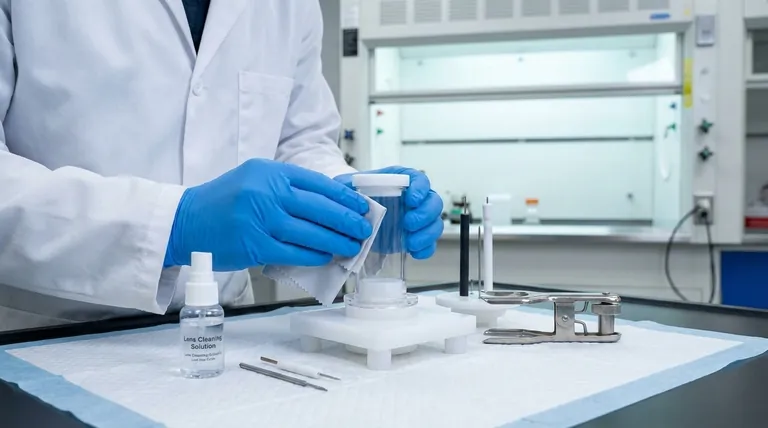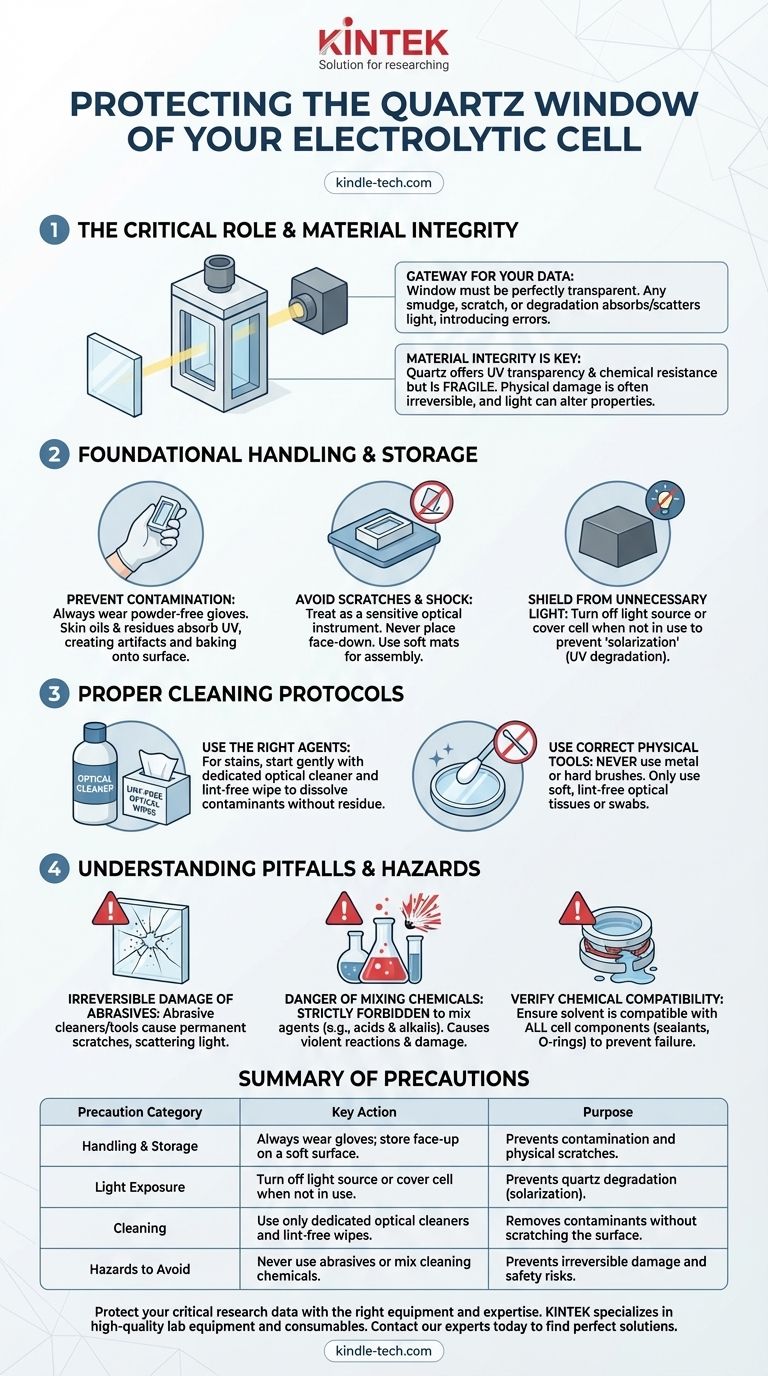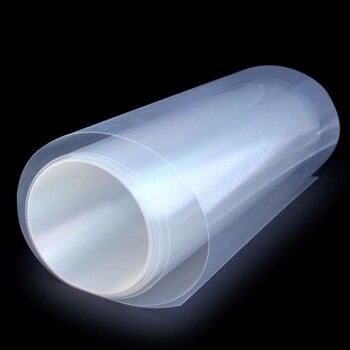To protect the quartz window of an electrolytic cell, you must handle it with care, clean it correctly, and shield it from unnecessary stress. This involves always wearing gloves to prevent skin oils from contaminating the surface, using only dedicated optical cleaners for stains, and covering the cell or turning off the light source when not in use to prevent material degradation.
The quartz window is the most critical and fragile component for obtaining accurate optical data from your cell. Protecting it is not just about routine maintenance; it is a fundamental practice for ensuring the integrity and reproducibility of your experimental results.

The Window's Critical Role
A spectroelectrochemical cell combines electrochemistry with spectroscopy. The quartz window is the interface that allows light to pass through the electrolyte and reach a detector.
The Gateway for Your Data
The window must be perfectly transparent at the wavelengths you are measuring. Any smudge, scratch, or degradation on its surface will absorb or scatter light, introducing significant errors into your spectroscopic measurements.
Material Integrity is Key
Quartz is used for its excellent UV transparency and chemical resistance. However, it is not indestructible. Physical damage is often irreversible, and chemical or light-induced damage can permanently alter its optical properties.
Foundational Handling and Storage
Simple, consistent habits are the most effective way to protect the window from the most common sources of damage.
Prevent Surface Contamination
Always wear powder-free gloves when handling the cell. Oils and residues from your skin can absorb UV light, creating artifacts in your spectra. These contaminants can also bake onto the surface under high-intensity light, becoming very difficult to remove.
Avoid Scratches and Physical Shock
Treat the cell as a sensitive optical instrument. Never place it face-down on a hard surface. When assembling or disassembling the cell, do so on a soft, clean mat and avoid using tools that could slip and strike the window.
Shield from Unnecessary Light
When an experiment is not actively running, turn off the spectrophotometer's light source. If that is not practical, use an opaque cover for the cell. Prolonged exposure to high-intensity light, especially in the UV range, can cause "solarization," a process that degrades the quartz and reduces its transparency over time.
Proper Cleaning Protocols
Improper cleaning can cause more damage than the contamination itself. Follow a strict protocol.
Use the Right Cleaning Agents
If the window becomes stained or dirty, begin with a gentle method. A dedicated optical cleaning solution and a lint-free optical wipe are the industry standard. These are designed to dissolve contaminants without leaving a residue.
Use the Correct Physical Tools
Never use a metal or hard-bristled brush on any part of the cell, especially the window. These will cause microscopic scratches that permanently scatter light. Use only soft, lint-free optical tissues or swabs specifically designed for cleaning lenses and windows.
Understanding the Pitfalls and Hazards
Knowing what to avoid is as important as knowing what to do. Certain actions can lead to immediate and irreversible damage or create a safety hazard.
The Irreversible Damage of Abrasives
Any abrasive cleaner or tool will permanently damage the window's optically flat surface. Scratches cannot be polished out and will create a constant source of error by scattering light away from the detector.
The Danger of Mixing Cleaning Chemicals
It is strictly forbidden to mix different types of cleaning agents, particularly acid and alkaline solutions. For example, mixing nitric acid and a sodium hydroxide solution can cause a violent, exothermic reaction, potentially damaging the cell and creating a significant safety risk.
Verifying Chemical Compatibility
Before cleaning, always verify that your chosen solvent is compatible with all components of the cell, not just the quartz. The sealants, O-rings, and cell body may be degraded by aggressive solvents, leading to leaks and catastrophic failure.
Making the Right Choice for Your Goal
Your specific actions should be guided by your immediate objective, whether it's routine use, deep cleaning, or long-term storage.
- If your primary focus is routine measurement: Your discipline in handling is paramount. Always wear gloves and shield the cell from light between experiments.
- If your primary focus is deep cleaning: Begin with the mildest effective solvent and use only professional-grade optical wipes to avoid scratches.
- If your primary focus is safety and longevity: Never mix cleaning chemicals and always double-check that your electrolyte and cleaning solutions are compatible with all cell materials.
Treating the quartz window with meticulous care is the single most important factor in guaranteeing the long-term accuracy and reliability of your spectroelectrochemical data.
Summary Table:
| Precaution Category | Key Action | Purpose |
|---|---|---|
| Handling & Storage | Always wear gloves; store face-up on a soft surface. | Prevents contamination and physical scratches. |
| Light Exposure | Turn off light source or cover cell when not in use. | Prevents quartz degradation (solarization). |
| Cleaning | Use only dedicated optical cleaners and lint-free wipes. | Removes contaminants without scratching the surface. |
| Hazards to Avoid | Never use abrasives or mix cleaning chemicals. | Prevents irreversible damage and safety risks. |
Protect your critical research data with the right equipment and expertise.
KINTEK specializes in high-quality lab equipment and consumables, including spectroelectrochemical cells and compatible cleaning supplies. Our products are designed to meet the stringent demands of laboratory research, ensuring the longevity of your equipment and the integrity of your results.
Let us help you maintain peak experimental performance. Contact our experts today to find the perfect solutions for your laboratory's needs.
Visual Guide

Related Products
- Quartz Electrolytic Electrochemical Cell for Electrochemical Experiments
- H-Type Double-Layer Optical Electrolytic Electrochemical Cell with Water Bath
- H Type Electrolytic Cell Triple Electrochemical Cell
- PTFE Electrolytic Cell Electrochemical Cell Corrosion-Resistant Sealed and Non-Sealed
- Electrolytic Electrochemical Cell for Coating Evaluation
People Also Ask
- What are the available volumes and dimensions for the all-quartz electrolytic cell? Find the Perfect Fit for Your Lab
- What are the key features of quartz that make it suitable for electrolytic cells? Discover the 4 Pillars of Superior Performance
- What are the necessary steps to prepare an all-quartz electrolytic cell before an experiment? Ensure Accuracy and Safety
- What materials are used to construct the all-quartz electrolytic cell? A Guide to Purity and Performance
- What are the standard opening specifications for sealed and unsealed all-quartz electrolytic cells? Optimize Your Electrochemistry Setup

















